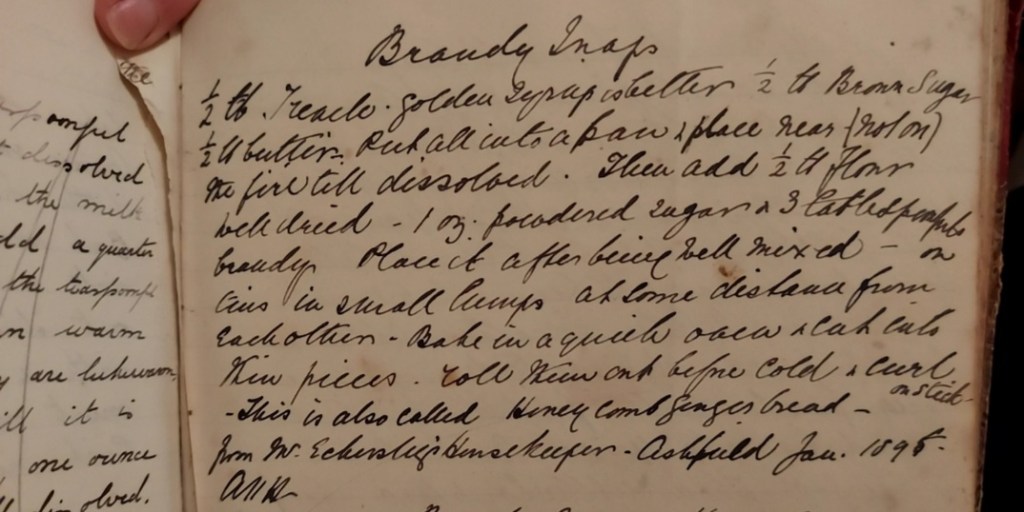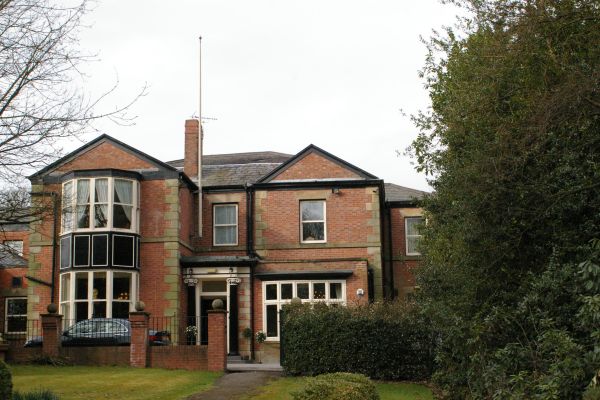
The pages in Maimie’s book are not numbered but this recipe features on what would be page five. Intriguingly, a number of pages before this one have been cut out and part of a recipe for ‘Rolls’ on the page opposite has been crossed out. Maimie’s recipe book can only be called slapdash when compared with that of her mother Althea’s, where the pages are numbered, there is an index at the back and the majority of recipes are dated, and even attributed. However, the hand of Althea is never far from this book too, as this recipe is in her handwriting and she has initialled it at the bottom: ‘ANH‘.

It is interesting that this recipe contains brandy as several sources state that brandy snaps do not and that the name comes from ‘brand-schnap’, the brand meaning burnt. There is an earlier recipe in Althea’s book that, sure enough, does not contain brandy (although it does have some interesting spice additions, so I look forward to trying it at some point). In the early 1800s, they were apparently called Jumbles and others know them as Fairings, although Fairings to me are more biscuity. Althea notes in the recipe that ‘this is also called Honeycomb Gingerbread’ but, to me, that is Cinder Toffee! All of which goes to illustrate the shifting sands of food terms.
I always thought there was something a bit posh about Brandy Snaps when I was growing up, even though the only place I ever recall them being sold was my local garden centre! I had never attempted to make them before as they looked complicated and intricate. I adjusted the quantities down in this recipe, omitted the powdered sugar and sneaked in a pinch of ginger powder but otherwise remained faithful. (I later filled them with with whipped cream, mixed with brandy and stem ginger, which deviated entirely from the recipe above!) With or without cream, they were delicious.
The ‘Mr Eckersley’ mentioned was James Carlton Eckersley, Justice of the Peace, who lived at Ashfield House in Standish, Wigan. His housekeeper’s name was Mary Bailey, a Yorkshire lady in her forties, who had kept house previously for James’s father Nathaniel, until he passed away in 1892. Nathaniel was a mill-owner, mine-owner, member of parliament and banker. During the first half of the nineteenth century, technological advances saw the number of cotton mills in Wigan jump from eight in 1819 to 38 by 1835; the Eckersley family built several of them. They were also renowned for their philanthropy in the local area.

Maimie’s family were certainly rubbing shoulders with the great and good. When Nathaniel died, he left £97,172, which equates to a comfortable £8 million in today’s money. By the time James Carlton died in 1926 he left £294,000 to his brother, which today would be a cool £18.1 million. My Harrisons certainly didn’t seem to have this sort of money. They might have known the Eckerlseys through their own connections with industrial Lancashire, as they too had made their money in cotton and woollen mills – in Bury, so not far from Wigan. Equally, James Carlton Eckersley was a JP for Lancaster, whereas James Harrison, Maimie’s father, fulfilled the role in nearby Lancashire and Westmorland. I suspect that, at this time, when you reached a certain social standing in an area, everyone just knew everyone else!
The early months of 1895, when this recipe appears to have been copied, made history as one of the most severe winters on record. Waterways across the country froze hard enough to make ice-skating possible, including on Lake Windermere.

The Harrisons lived at the foot of Lake Windermere. Would skating on the lake have been ‘the done thing’ for people like them? Maimie did not leave a diary and so, to try and work out how they might have lived, I rely on her sister’s tiny diary (mentioned in this post and this one), as well as other contemporary records.
Barbara Sneyd was a neighbour of the Harrisons, who lived at Finsthwaite House, less than two miles away. Although she was some fifteen years younger than Maimie, the families clearly knew each other, as she was one of Maimie’s bridesmaids. The diaries that she kept between 1896 and 1903 (published by Pelham Books as Riding High) are representative of the sort of ‘country house’ existence that Maimie and sister Edith would have also enjoyed: outdoor pursuits such as riding and walking in the mountains; visits to the seaside, London or to the Grand National in Liverpool; and holidays on the Continent. In 1902, Barbara writes of an aborted trip to nearby Bardsea to play ice hockey on the frozen sea, so skating must have been in fashion for the upper middle classes.
Back at Windermere in 1895, it sounded like a once-in-a-lifetime spectacle. It was estimated that 20,000 flocked to its shores to skate. People travelled from all over the north-west and beyond to experience it. Mr. Thomas A. Leigh wrote a letter to the Liverpool Mercury, encouraging the people of his city to catch the train to Windermere to enjoy the skating; he wrote of ‘a band of music, which can be heard for miles, tents and booths for refreshments…to say nothing of the splendid scenery, which is now quite Alpine.’
Another account, by a resident of Nottinghamshire who had also travelled by train described the scene:
‘Thousands of people were disporting themselves on the ice, some indulging in the “roaring” game of curling, some hard at hockey, others cycling, and one enterprising inhabitant doing a roaring trade with a pony and trap…Altogether it was a sight not to be forgotten.’
It all sounds like great fun. Maimie would have been 27 years old. Was she too old and sensible to participate in the skating on her doorstep? It’s impossible from old photographs to deduce what sort of personalities people had; everyone back then tended to look dour, or even cross, in photos. Certainly, from her diaries, Maimie’s little sister Edith seemed a fun-loving sort, so I like to think they took to the ice like everyone else.

I, too, like to think Maimie would have been there with the rest, taking advantage of a once in a lifetime event!
LikeLiked by 1 person
Me too – it sounds magical, I don’t think anyone could resist it, surely?
LikeLiked by 1 person
Lots of fun here! You’re lucky to have all this detail available to you. As to the brandy snaps? Pass. My dentist would want me to.
LikeLiked by 1 person
If you leave them a couple of days, the cream makes them soggy 😉
LikeLiked by 1 person
True. But soggy brandy snaps? 😉
LikeLike
Pingback: Wafer Puddings | Eating With The Ancestors